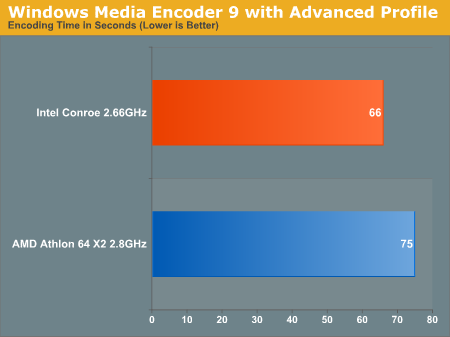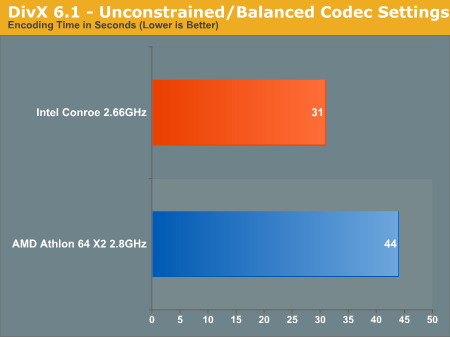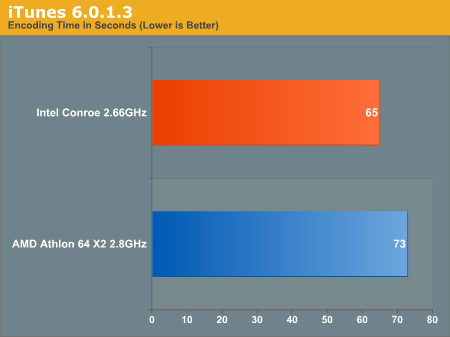Spring IDF 2006 Conroe Preview: Intel Regains the Performance Crown
by Anand Lal Shimpi on March 7, 2006 3:58 PM EST- Posted in
- Trade Shows
Media Encoding Performance
Intel also had a DivX 6.1 and an iTunes 6.0.1.3 test loaded on the machine for our use. The scores speak for themselves, Conroe showed just under a 30% performance advantage in DivX encoding and 11% in MP3 encoding. Updated: Windows Media Encoder 9 with Advanced Profile, the same test that we use in our CPU reviews, is showing Conroe with a 12% advantage over the 2.8GHz AMD system.













220 Comments
View All Comments
Questar - Tuesday, March 7, 2006 - link
I assume then your apps use SSE. Conroe basically doubles SSE performance.dstz - Tuesday, March 7, 2006 - link
Seconding the poster above about some FPU informations.And there i speak for myself : it's really about the FPU. Some commercial audio plugins (VST) may be SSE optimized, but one shouldn't take that for a given. So it's really the FPU that matters when looking for a audio synthesis oriented system, and near futur doesn't seem quite brillant for FPU heavy users :-(
clnee55 - Tuesday, March 7, 2006 - link
If more articles come out of IDF, there might be a problem with AMD fanboys. The hospitals might be too busy to handle such many heart attacks. Come on, fanboys. It is just a chip. No matter what chip you use, thank you for continue upgrading your system. It helps to drive the US economy. I hope every body will upgrade to Conroe this year and then upgrade again next year when K8.5 or K9 comes out.rayo123 - Tuesday, March 7, 2006 - link
I can't drive the economy by buying those chips, if the chips don't help me to make more money! That usually means FPU performance, not games!!!munky - Tuesday, March 7, 2006 - link
Something definitely looks fishy in the FEAR benchmark. Fear is such a gpu-intensive game, there's no way you'd see such a huge boost just from the cpu alone. Check out how FEAR scales on a single 7800gt at medium settings, 1024 x 768:http://www.xbitlabs.com/articles/cpu/display/28cpu...">http://www.xbitlabs.com/articles/cpu/display/28cpu...
The difference between a slow P4 and a FX57 is less than the supposed difference between the 2.66ghz Conroe and the 2.8ghz A64. Until I see some official benches from reputable sites, I'm gonna be skeptical about Intel's new "benches"
Accord99 - Tuesday, March 7, 2006 - link
But they're not using a 7800GT. They're using a pair of 1900XTs, which are massively more powerful in shader-heavy games like FEAR.EnergyWatcher - Tuesday, March 7, 2006 - link
...at 73 seconds, when this benchmark (http://www.anandtech.com/printarticle.aspx?i=2668">http://www.anandtech.com/printarticle.aspx?i=2668 ) shows it at 32? And this despite the fact that today's benchmark is supposedly using an FX-60 overclocked to 2.8GHz, and the previous benchmark used one stock (2.6GHz)?Could this have something to do with the BIOS abnormalities I've already noted?
Something is extremely fishy here.
-e
Briggsy - Tuesday, March 7, 2006 - link
IF the AMD system used such an old BIOS, then is it possible that the BIOS would not have enabled processor specific enhancements since it was written - SSE2 for example?How do the benchmarks shown compare with other reviews online currently? Sure, they aren't directly comparable, and I would hope that Intel wouldn't cripple the competitor's board intentionally when their processor is so far ahead it wouldn't change the result in all likelyhood, but it would be an interesting comparison.
Questar - Tuesday, March 7, 2006 - link
Try anything to pick apart an Intel win, eh?Bladen - Tuesday, March 7, 2006 - link
It doesn't say it uses the same file for that test as the previous test...